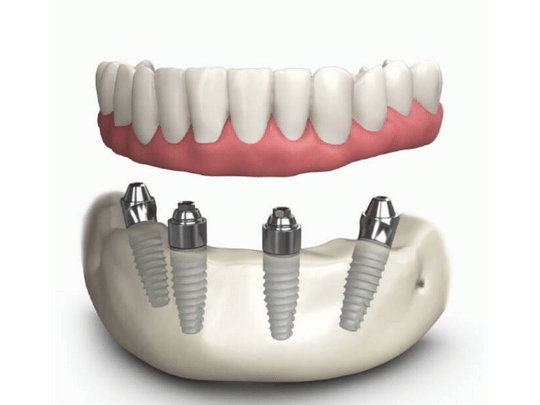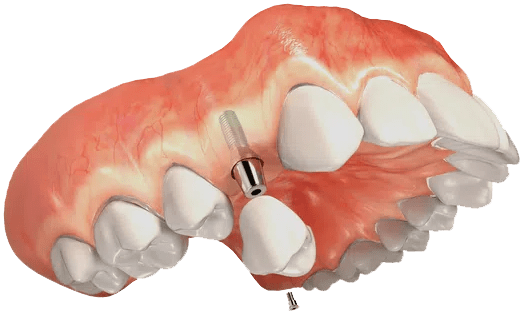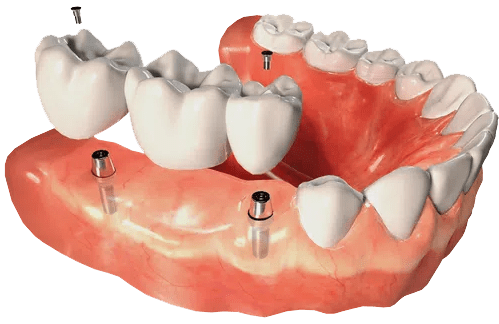
Missing a tooth or teeth can be demoralizing and embarrassing. With modern technology it is possible to restore your smile and confidence through dental implants.
Although there are several different procedures for replacing teeth, dental implants are the most natural replacement for missing teeth. They do not require alterations in adjacent teeth, and the dental implant post stimulates your jawbone in the same way as your natural teeth. This leads to less bone loss and preserves a younger facial appearance.

A natural tooth is anchored into the jawbone by its tooth root. Tooth roots attach firmly to the jawbone and keep your teeth stable when chewing foods.
Traditionally, if you were missing a tooth or if one needed to be extracted, the healthy teeth on either side of the missing tooth would be cut down and the whole thing replaced with a three-crown “bridge”.
Dental implants are the modern alternative. Instead of cutting down two perfectly healthy teeth, your dentist inserts a dental post (dental implant) into the jawbone to replace your missing tooth root. This post becomes solidly fixed into your jaw as the bone heals (like a natural tooth root). Your general dentist then places a crown onto this artificial tooth root that feels and functions like your natural teeth.
Quite simply, dental implants are the most natural replacement for missing teeth.

Traditionally, several missing teeth would have been replaced with a removable partial or full denture.
Dentures have to be taken out and soaked at night. During the day, they can also look unnatural and rub painfully. Dentures and partials make it difficult or impossible to eat certain foods.
Dental implants can now be used to anchor partial and full dentures. This prevents the slipping, irritation, and pain associated with “floating” partials and dentures. It also prevents the tedious removal of dentures for overnight soaking and cleaning. Dental implants also eliminate the need for dental adhesives. This allows you to enjoy eating the foods you previously avoided . With dental implants, your partials or dentures are firmly anchored to the jawbone, causing them to feel much more like natural teeth.
Natural tooth roots and dental implant posts are fixed firmly in your jawbone. When you chew, these tooth roots and posts stimulate the jawbone and prevent it from shrinking. You may have seen a person who looked prematurely old because their jawbone had shrunk after wearing floating dentures. Dental implants help preserve your jawbone and appearance.
● Made from acrylic or porcelain
● Support from 2+ implants
● May need relines or repairs
● Won't slip, loosen, or fall out
● Greater stability for eating
● Removable for easy cleaning
● Improves jawbone health
● May Not look or fee Natural
● Moderate treatment cost
● Qualifies for dental financing
● Designed from block of zirconi
● Fixed to 4-8 implants
● Comparable to Natural Teeth
● Restores over 98% Function
● Promotes health jawbone
● Resistant to bacteria and decay
● Fracture and Chip resistant
● Improves oral and Overall health
● Cared foe like natural teeth
● No Additional Maintenance
● Highest Treatment cost
● Qualifies for dental fiancing
After their healing period, the success rate of dental implants is between 94% and 98%. If you are a non-smoker with good oral hygiene, the percentage is closer to 98%.
The discomfort involved with receiving a dental implant is similar to that of having a cavity filled. It is often done under local anesthesia and patients generally experience little discomfort after the procedure.
Dental implants become fixed to the jawbone. Though the life span of a dental implant will vary with each patient, many have lasted for over 30 years. With good oral hygiene and regular cleanings, dental implants should last a lifetime. In contrast, the average life span of a traditional fixed bridge is between 10-15 years.
A critical question in determining whether an implant can be placed is, “Is there enough bone to support the implant?” Fortunately, advanced bone regeneration techniques now make it possible to place many more implants than just 10 years ago.
Dental implant treatment begins with an evaluation to determine if you are a good candidate for this procedure. If you are interested in dental implants, contact us for a placement evaluation.